Tobermory, Ontario 作者: 来源: 发布时间:2021-12-09
I.Population and Area
-Area
•Land: 156 square miles
-Population
•Total: 3,999
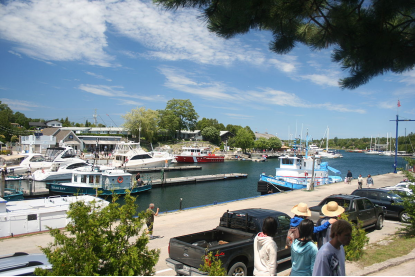
II.Natural Geography (environment and resources)
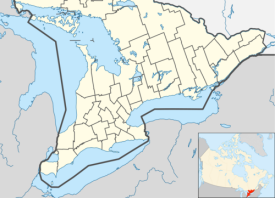
-Tobermory is a small community located at the northern tip of the Bruce Peninsula in the municipality of Northern Bruce Peninsula. It is 300 kilometres (190 miles) northwest of Toronto. The closest city to Tobermory is Owen Sound, 100 kilometres (62 miles) south of Tobermory and connected by Highway 6. Due to similar harbour conditions it was named after Tobermory (/ˌtoʊbərˈmɔːri/; Scottish Gaelic: Tobar Mhoire), the largest settlement in the Isle of Mull in the Scottish Inner Hebrides.
-The community is known as the "fresh water SCUBA diving capital of the world" because of the numerous shipwrecks that lie in the surrounding waters, especially in Fathom Five National Marine Park. Tobermory and the surrounding area are popular vacation destinations. People come for the beaches, the diving, the unspoilt countryside and the relaxed pace of life. The town lies north of the Bruce Peninsula National Park.
-The MS Chi-Cheemaun passenger-car ferry connects Tobermory to Manitoulin Island in Lake Huron. Tobermory is also the northern terminus of the Bruce Trail, and has twin harbours, known locally as "Big Tub" and "Little Tub". Big Tub Harbour is Canada's largest natural freshwater harbour.
-The Grotto in Bruce Peninsula National Park
-Tobermory is typically a few degrees colder than Toronto. Most of the businesses in the town are open from May until the Thanksgiving long weekend in October, and are closed for the other seven months of the year.
III.ECONOMY
-Average salary: $52.76 per hour

-Website: https://ca.indeed.com/salaries/pharmacy-manager-Salaries,-Tobermory-ON
IV.Industrial Characteristics
-We all know where our mainstreets are, but do we know what they are and why they matter? Whether they are named First Avenue or King Street, are a County Road or Provincial Highway, what they represent is universal. Mainstreet is the economic engine, the big stage, the core of the community. Bruce County’s mainstreets represent over 70 % of our commercial assessment and are our main point of contact with tourism dollars – our second largest industry. Our mainstreets tell us who we are and who we were, and how the past has shaped us. We do not go to our commercial strips to learn about our past, explore our culture, or discover our identity. Our mainstreets are the places of shared memory where people still come together to live, work, and play.
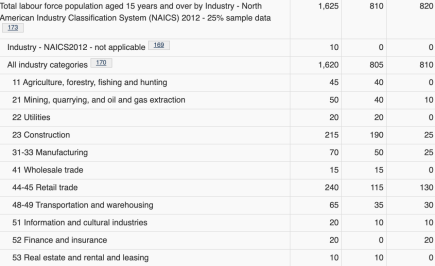
-Website: https://www12.statcan.gc.ca/census-recensement/2016/dp-pd/prof/details/page.cfm?Lang=E&Geo1=CSD&Code1=3541069&Geo2=PR&Code2=35&SearchText=Northern%20Bruce%20Peninsula&SearchType=Begins&SearchPR=01&B1=All&GeoLevel=PR&GeoCode=3541069&TABID=1&type=0
V.Attractions
1.Fathom Five National Marine Park
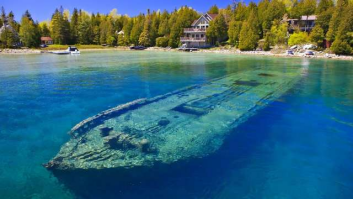
-Fathom Five National Marine Park is a National Marine Conservation Area in the Georgian Bay part of Lake Huron, Ontario, Canada, that seeks to protect and display shipwrecks and lighthouses, and conserve freshwater ecosystems. The many shipwrecks make the park a popular scuba diving destination, and glass bottom boat tours leave Tobermory regularly, allowing tourists to see the shipwrecks without having to get wet.
-Many visitors camp at nearby Bruce Peninsula National Park and use the park as a base to explore Fathom Five and the surrounding area during the day.
-Fathom Five also contains numerous islands, notably Flowerpot Island, which has rough camping facilities, marked trails, and its namesake flowerpots, outlying stacks of escarpment cliff that stand a short distance from the island, most with vegetation (including trees) still growing on them.
-Established in 1987, the park represented a pioneering departure for the national park system, which had centred on land-based conservation until then. Its designation as a National Marine Park foresaw the creation of others, though nomenclature for such units would morph into National Marine Conservation Areas, leaving Fathom Five as the only National Marine Park. Despite its unique name, it is categorized as an NMCA and is deemed the first one in the country.
-Telephone: 519-596-2233
-Toll-free: 1-888-773-8888
2.Flowerpot Island
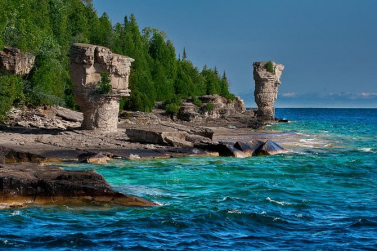
-Flowerpot Island is an island in Georgian Bay, in the Canadian province of Ontario and is a part of Fathom Five National Marine Park. The island spans 2.1 kilometres (1.3 mi) from east to west, and 1.5 kilometres (0.93 mi) from north to south, and has a total area of 2 square kilometres (490 acres). The name of the island comes from two rock pillars on its eastern shore, which look like flower pots. A third flowerpot once stood, but tumbled in 1903.
-Flowerpot Island is a popular tourist destination, with camping facilities and hiking trails. The island is accessible by cruises and rigid inflatable boats from Tobermory on the Bruce Peninsula.
-Email: cruises@bruceanchor.com
-Website:https://cruises.bruceanchor.com/contact-us/
3.Big Tub Lighthouse
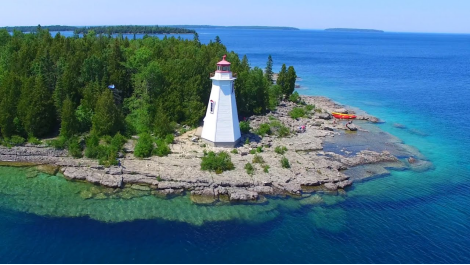
-Big Tub Lighthouse is an active lighthouse located near Tobermory in Bruce Peninsula, Ontario, Canada. The lighthouse was originally lit in 1885 and is still used up to this day.
-The lighthouse was originally built in 1885 when the Department of Marine bought the lots for the lighthouse and John George and David Currie constructed the lighthouse to prevent anymore ship accidents as the entrance to the Tobermory Harbour was hard to navigate and was often used as an asylum from bad weather. The lighthouse has a focal height of 13.2 metres (43 ft) and has a range of 11 nautical miles (20 km; 13 mi).
-Address: Big Tub Road, Tobermory, Ontario Canada
-TEL: +1 519-596-2452
VI.History
-Man has inhabited the general area for over 3000 years, but because the previous inhabitants were farmers, then the inhabited areas were Prior to this time, the majority of the population lived at Baliscate at the top of the Eas Brae (Eas meaning ‘Waterfall’). The only real evidence that can be seen of early settlements are the Standing stones at Baliscate and an Iron age fort near to the farm at Sgriob Ruadh. The fort is called Dun Urgadul and is thought to have been in use between 600 B.C. and 400 A.D.
-The town of Tobermory was established in 1788, created by the British Fisheries Society. The society had decided that Tobermory should be one of three new habitations to be developed. The other two being Ullapool and Lochbay in Skye. In 1788 the building work began.
-Where the Main Street now sits had been nothing more than a rocky cliff face with a small piece of flat ground at Ledaig (where the distillery is now situated) that supported a small settlement. To start building the new Tobermory, the site had to be created by cutting away at the steep slope and reclaiming land from the sea. A small pier and customs house were the first structures to be built so that the salt could be landed and taxes could be levied. Most fish was transported in salt to preserve it, and salt was taxable. The current post office was the customs house and store. Other buildings were then constructed in this area, including an inn (where the co-op is now). this was to be the core of the village. Land was precious, and so, to allow the village to expand, accommodation land was released at the top of the hill. Argyll Terrace was developed and named after the 5th Duke of Argyll.
-The new village was expected to attract people currently working on the land and to develop their skills into being fishermen and tradesmen. This never really worked, as few local people had either the knowledge or finance to build boats and head way out to see and catch Herring. In the end other factors help develop this part of scotland. Kelp was being harvested for processing into soap and glass. This meant that the pier had to be extended and this increased trade.
-The boom in Kelp however, was only temporary and the trade collapsed in the 1820’s and lean years were ahead for the village. As in recent years, tourism came to the rescue and after visits by notables like Mendelssohn the village became a stopping off place for people visiting the Hebrides and Fingal’s Cave. In 1847 Queen Victoria visited Tobermory in the Royal Yacht (Victoria and Albert)and described Tobermory as “prettily situated” The town then had a reputation for being on the ‘Royal Route’ and Steamships Companies used this description in its advertising material to attract people onto its cruises. The promotion worked, and the village didn’t look back. By now the village had around a thousand inhabitants and the buildings were developing outwards to the north. The area where the Mishnish pub is now standing was constructed and more seawall was extended to carry the road. In 1864 a new deep water pier was completed to service larger vessels that had become necessary to service all the growing small communities up the West Coast of Scotland. The importance of Tobermory’s safe harbour was now as important as ever to passing vessels. More vessels meant more trade and the Tobermory shops developed and with them the necessary trades.
-Website: http://www.tobermory.co.uk/activities/historical-attraction/history/
VII.Other information
-Tobermory Hyperbaric Facility
-The Tobermory Hyperbaric Facility has an educational program for divers which includes lectures and recompression chamber runs. This, combined with ongoing diving research, continues to enhance diver safety.
-The program ensures ongoing availability of support for sport, commercial and scientific diving by providing:
•lectures and instructional chamber dives
•improved response to diving problems through investigation and research
•training in defensive diving techniques
•assistance with the investigation of diving mishaps and casualties
•emergency medical services directly or via remote support
-Website: https://tobermory.com/services/tobermory-medical-clinic
VIII.Contact information
-Government
•Mayor: Mayor Milt McIver
•Telephone: (519) 592-3076
•mayor@northernbruce.ca
•Website: https://www.northbrucepeninsula.ca/en/municipal-services/mayor-and-council.aspx#
-Address
•Tobermory
Visitor Information Centre
7420 Highway 6 | P.O. Box 250
Tobermory, Ontario, N0H 2R0
Canada
-Phone: 519-596-2452
-Email: info@tobermory.org
